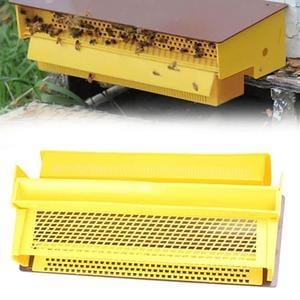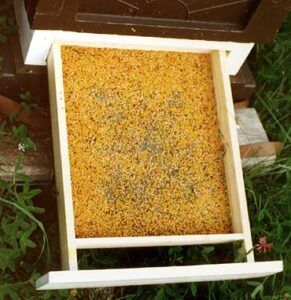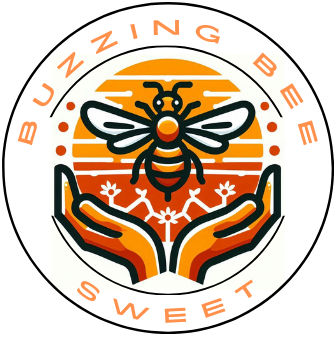Pollen traps might sound like something from a sci-fi flick, but they’re an everyday tool in a beekeeper’s kit. Designed to collect pollen from foraging bees, these nifty gadgets help you keep track of what’s going in and out of your hive. By doing so, beekeepers can monitor and enhance hive health, ensuring those buzzing buddies are at their best.
Now, why should you care about pollen traps if you’re just digging into beekeeping? Well, aside from really wanting to know where your bees are working their tiny wings off, pollen traps play a crucial role in maintaining hive health. These tools help beekeepers gather insights into the nutritional intake of the hive, envisioning the nutritional landscape bees navigate. This ‘intel’ can point out deficiencies in the environment and help decide if you need to add a little supplementary diet for your bees.
There are a few types of pollen traps to consider when deciding what’s right for you. The most common ones are front-mount traps and top-mount traps, both having their perks and quirks. Front-mount traps are attached to the entrance of the hive and catch pollen as the hardworking bees return home. They’re easy to install but can add a bit of stress to the bees. Top-mount traps go on the hive’s roof, which could mean less hassle for the bees but might require a bit more finesse in your handling.
Figuring out which trap aligns with your bees’ needs and your beekeeping goals will set you on the path to making informed, bee-friendly choices. Balancing efficiency with sustainability is key, ensuring that your intervention aids the hive rather than hinders it.
How Pollen Traps Work: An In-Depth Look


Pollen traps operate on a simple yet genius concept. As bees return to their hive, they pass through a grid or sieve in the trap. This grid is just the right size to brush off some of the pollen clinging to their legs, allowing it to fall into a collection tray, while the bees continue on their way.
Installing a pollen trap requires a gentle hand and a keen eye. Most pollen traps are designed to be easy and quick to set up—no PhD in bee management required. Typically, you’ll find them installed at the hive entrance or on top of the hive. Start by securing the trap to ensure it stays in place. It’ll need to be snug enough so adventurous bees can’t worm their way around it.
Now, there are a few things to watch when you’ve got a pollen trap working. First off, keep an eye on how your bees handle the new addition. Sometimes, they might take a minute to figure it out. Let ’em get used to the routine. If you see that traffic into the hive is sluggish, it might be time to check that grid spacing. Too tight, and you’ll be blocking your bees; too loose, and you’re losing all that golden pollen you’re trying to gather.
The cool part about pollen traps is they act kind of like bee counters. You get this daily snapshot of what kinds of pollen your bees are bringing back, a critical insight into their foraging zones and preferences. This can help you make informed decisions about hive location, additional feeding, or even which floral sources are booming in your area.
It’s also essential to periodically empty that collection tray, especially when it’s buzzing with bee activity. This keeps the setup running smoothly and ensures fresh pollen for any projects or sales you might have planned.
Benefits of Using Pollen Traps in Beekeeping
Pollen traps come with a bundle of perks that make them a worthwhile addition to your beekeeping toolkit. One standout benefit is the boost in hive productivity and honey quality. Collecting pollen allows you to assess the nutritional intake of your bees. When they’re getting the right nutrients, you often notice a bees-in-great-shape scenario: increased honey production, improved brood health, and vibrant hive activity.
Another huge win is the ability to monitor bee health closely. Through pollen analysis, you can track any shifts in diet or exposure to pesticides, which might trigger alerts about environmental threats. This gives you the upper hand in addressing potential issues before they spiral into major problems, ensuring your tiny winged workers stay healthy and productive.
And hey, did you know that collected pollen can be a surprising source of income? That’s right! Pollen is like a health treasure in the wellness world, packed with proteins, vitamins, and minerals. Many people consider it a superfood. So, by gathering and processing the pollen your bees collect, you can explore new market streams, selling it as a nutritional supplement or ingredient in health products.
This side hustle with pollen can complement your honey production, offering a diversified income. It also sets you ahead, sprinkling a little sustainability and efficiency onto your beekeeping operations.
Challenges and Considerations with Pollen Traps
Working with pollen traps isn’t always a smooth ride, and it’s important to be aware of a few hurdles you might face along the way.
- One of the main challenges is the potential stress on bees. Constantly running into a pollen trap can alter a bee’s foraging pattern and some might not be too thrilled with the setup. If your buzzing buddies seem stressed or you’re noticing reduced hive activity, it might be time to ease up a bit and reconsider the trap’s placement or design.
- Another aspect to keep in check is the impact of environmental conditions on the efficiency of these traps. Weather, pollen availability, and surrounding flora all play a crucial role. Adverse weather conditions like windy days might affect the amount of pollen collected, as bees’ travel paths might differ or they might go less frequently.
- There’s also the maintenance side to think about. Pollen traps need regular cleaning and checking for blockages or wear. Neglecting this can lead to reduced effectiveness and even harm to the bees if they can’t get through the way they’re supposed to. Good housekeeping here means avoiding mold growth in the collected pollen, which might otherwise spoil the whole batch.
- You might also find troubleshooting required for issues like under-collection or over-collection of pollen. Both scenarios are not ideal. Under-collection could mean your trap isn’t set up properly, while over-collection might denote it’s too harsh on the bees’ pollen needs. Balancing this collection is key.
Taking these considerations seriously ensures that your pollen traps work in harmony with your hive, supporting rather than undermining your beekeeping efforts.
Best Practices for Optimizing Pollen Trap Use
Choosing the right pollen trap is your first step towards a balanced beekeeping approach. You’ll want to consider the needs of your bees and your environment before making a decision. While some traps are more suited to certain climates or types of hives, it’s important to pick one that doesn’t overly disrupt your bees’ daily grind.
A key practice is to monitor and adjust the trap’s collection frequency and duration. Running a pollen trap constantly isn’t ideal, as it can stress out the bees. Aim for a schedule that allows your bees to have those essential rest days without any hindrance from the trap.
Ethical use of your pollen trap is crucial. This means ensuring you’re leaving enough pollen for the bees, so their nutrition isn’t compromised. After all, they’re working hard to sustain the hive, and snatching away their hard-earned supplies shouldn’t be the goal.
Storing and processing collected pollen correctly ensures its quality and usability. After collecting, pollen should be dried quickly and stored in a moisture-free environment to maintain its nutritional value. This not only extends its shelf life but also enhances its marketability if you’re selling it.
Developing a systematic approach to maintenance and inspection ensures your traps are a benefit rather than a burden. Regular checks and cleaning will help prevent any issues that could disrupt bee activity or lead to damages in the hive.
This post may contain affiliate links.

You explained everything so clearly, from how pollen traps work to their benefits for beekeepers. I really appreciated the detailed step-by-step instructions on installing and maintaining the traps—it makes the whole process feel much more approachable, even for someone who might be new to beekeeping.
One thing I was wondering, though—when it comes to collecting pollen, do you find that there’s a certain time of year when it’s more effective to use the traps? I’d love to know if seasonality plays a big role in the amount or quality of pollen collected. Overall, this guide is super helpful and packed with practical info!
Hi Bob!
Thank you for your comments and questions!
Yes, collecting pollen is seasonal depending of what sort of flowers or trees are blooming and how much pollen you can harvest.
/Mats.